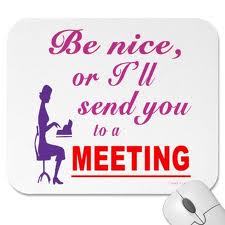So you have setup a the meeting. Congratulations. Now what?
To conduct an effective meeting, you need to have a clear agenda. And not just in your own head, but a published agenda that everyone is aware of, and agrees to.

A meeting is considered organized if we create some reading materials and send them out in advance, expecting everyone to be adults and prepare for the meeting. Now let's do a reality check - how many meetings does a person attend on average? Let's talk stats for a minute -
According to a 1998 MCI study (yes, that says 1998 - it was a different world back then - for those of you who were born and around), each day in the United States there are 11 Million meetings (Source: https://e-meetings.verizonbusiness.com/meetingsinamerica/pdf/MIA5.pdf). On a side note, how many meetings do you think we are having now in the U.S.? Senior Managers spend up to 23 hours a week in meetings (that's more than half a work week). So, all this leads me to the topic at hand - how do we get the most out of our meetings. What is the one thing we can do to take a step towards a better meeting environment?
Many times we send our materials, send the agenda, and expect people to show up prepared. We get mad when they don't, and blame how no one cares. Sound about right?

The invitees have fallen victim to the 'feed me' syndrome (commonly found in little kids). You don't have to be a powerhouse at the company to make sure people are prepared for the meeting. As the organizer of the meeting, you have to not only be organized yourself, you also have to help others get organized.
So what should you do?
When you send out the required materials, call out the sections specific people need to pay attention to. For example, if you are discussing a requirements document, there may be a sales section, marketing requirements, software architecture requirements and UI requirements. The marketing representative invited to the meeting only really needs to read the marketing section. They may want to glance over the sales section and the UI section so they know where the product is heading, and how the sales strategy ties into their marketing strategy, but that depends on how much time they have available and how much they can contribute to the other sections.

If you break down the reading materials and tell each of the invitees the sections they need to review, you may get more cooperation. Otherwise, they will see a 50 page document and decide to never have enough time to read the whole thing. This will result in people showing up with no background and no prep, and you will end up having a meeting about the meeting. You will eventually run out of time, and people will walk out frustrated, and the age old cliche of 'have a meeting to have the meeting' will hold true.
Just setting the agenda isn't enough. It's the first step.
Let's take the example I outlined above - if all you say is "review marketing, sales, technical and UI related requirements and answer questions to get final sign off", you have already lost the battle and set yourself up for 3-4 sessions with a bunch of folks who are showing up just because.
Try this on for size as the agenda:
Problem Statement: Requirements are in the final stages of review - final sign off needed by all stakeholders.
Time frame: Development team is ready to execute on these requirements in 2 days (xx/xx/xxxx)
Action Items:
Everyone: Review your sections as outlined below and send me questions or bring them to the meeting.
John (marketing): review sections 1 and 2 (pages 3 through 10).
Note: you may want to read section 5 for sales requirements but not required.
Jason (sales): review section 5 for sales requirements. May also want to review sections 1&2.
Terri (UI): Reviews designs in section 8, the problem statements of each of the sections outlined in the document.
This will help get everyone organized, and considering the short amount of time everyone has running between meetings, they can focus on what matters to them. They will thank you for pointing out what they should be focusing on, they can read their relevant sections.
To be sure, follow up once (without being a pest) and ask everyone if they need any help or if anything was unclear. It shows you care about the topic, care about what you are calling everyone for, and care for their feedback during the meeting.
Ofcourse, after the meeting send minutes and any follow up items.



